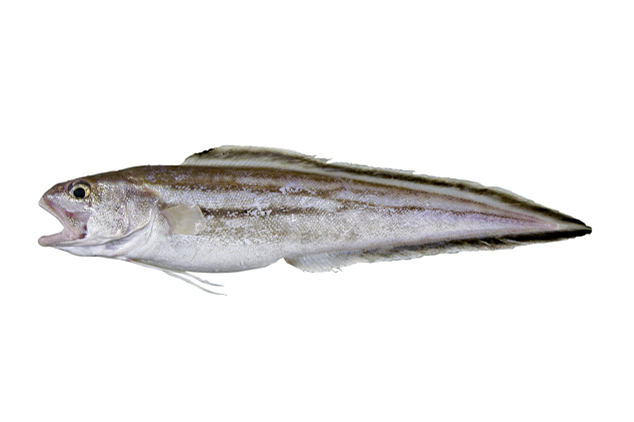Lined Cusk, Sirembo amaculata (Cohen & Nielsen 1982)

A Lined Cusk, Sirembo amaculata. Source: Australian National Fish Collection, CSIRO. License: CC by Attribution-NonCommercial
Summary:
Small Lined Cusks have horizontal stripes along the body that change to a vermiculate pattern on medium-sized fishes, before becoming blotched or slightly vermiculate in large specimens.
This species was previously known as Spottobrotula amaculata.
This species was previously known as Spottobrotula amaculata.
Cite this page as:
Bray, D.J. 2017, Sirembo amaculata in Fishes of Australia, accessed 20 Apr 2024, https://fishesofaustralia.net.au/home/species/5061
Lined Cusk, Sirembo amaculata (Cohen & Nielsen 1982)
More Info
|
Distribution |
Off Glomar Shoals to off Cape Boileau, Western Australia. Elsewhere the species occurs in the tropical, west Pacific. |
|
Features |
Dorsal fin 94-96; Anal fin 71-73; Vertebrae 51-52; Developed gill rakers 3-4. Body scales small, arranged in 130-145 regular rows along the side; base of pectorals with scales, none on bases of vertical fins; dense, small, fleshy papillae on lips; supraorbital pores 2; suborbital pores 5 ?; lateral pores 1; preoperculomandibular pores 8; temporal pores 1; pyloric caeca numerous, about 45. |
|
Colour |
Ontogenetic change in color pattern occurs; small individuals with horizontal bands on body; bands assuming a vermiculate pattern on medium-sized fishes; becoming blotched or slightly vermiculate in large specimens. |
|
Fisheries |
Occasionally taken as bycatch in commercial bottom trawls. |
|
Similar Species |
Sirembo amaculata differs from other species of Sirembo in the coloration that changes ontogenetically from a pale abdomen and alternating black and white horizontal bands on the body in smaller specimens (165–175 mm SL) to a darker abdomen and vermiculate bands in larger specimens (295–405 mm SL). The species also differs in the following combination of characters: pelvic fins inserted below preopercle; prepelvic length 15.5–20.5% SL; 17–20 scale rows between origin of dorsal fin and lateral line; 3–4 long rakers on anterior gill arch; pseudobranchs with 24–40 filaments; and pectoral fins with 24–28 rays. S. amaculata is most similar to S. jerdoni, with horizontal and oblique stripes on the head and body and an indistinct lateral line. S. amaculata differs from S. jerdoni by the number of scales between the origin of the dorsal fin and the lateral line (17–20 vs. 5–7) and by having a longer pelvic fin (19.0–25.0% SL vs. 12.5–15.5% SL, respectively). |
|
Species Citation |
Spottobrotula amaculata Cohen & Nielsen 1982, Copeia 1982(3): 497, fig. 1. Type locality: the Visayan Sea between northern Negros and Masbate Island, Philippines, 90m [11°38´N, 123°52´E]. |
|
Author |
Bray, D.J. 2017 |
|
Resources |
Lined Cusk, Sirembo amaculata (Cohen & Nielsen 1982)
References
Cohen, D.M. & Nielsen, J.G. 1982. Spottobrotula amaculata, a new ophidiid fish from the Philippines. Copeia 1982(3): 497-500 fig. 1 (as Spottobrotula amaculata)
Gloerfelt-Tarp, T. & Kailola, P.J. 1984. Trawled Fishes of Southern Indonesia and Northwest Australia. Jakarta : Dir. Gen. Fish. (Indonesia), German Tech. Coop., Aust. Dev. Ass. Bur. 406 pp. (as Spottobrotula amaculata)
Hoese, D.F., Paxton, J.R., Gates, J.E. & Bray, D.J. 2006. Ophidiidae. pp. 556-566 in Beesley, P.L. & Wells, A. (eds) Zoological Catalogue of Australia. Volume 35 Australia : ABRS & CSIRO Publishing Parts 1-3, 2178 pp. (as Spottobrotula amaculata)
Larson, H.K., Williams, R.S. & Hammer, M.P. 2013. An annotated checklist of the fishes of the Northern Territory, Australia. Zootaxa 3696(1): 1-293
Nielsen, J.G., Cohen, D.M., Markle, D.F. & Robins, C.R. 1999. Ophidiiform Fishes of the World. An annotated and illustrated catalogue of pearlfishes, cusk-eels, brotulas and other ophidiiform species known to date. FAO Fisheries Synopsis No. 125 Vol. 18. 178 pp. (as Spottobrotula amaculata)
Nielsen, J.G., Schwarzhans, W. & Uiblein, F. 2014. Review of the Indo-West Pacific ophidiid genera Sirembo and Spottobrotula (Ophidiiformes, Ophidiidae), with descriptions of three new species. Marine Biology Research 11(2): 113-134
Nielsen. J.G. 1999. Families Carapidae, Ophidiidae, Bythitidae, Aphionidae. pp. 1978-1985 in Carpenter, K.E. & Niem, V.H. (eds) The Living Marine Resources of the Western Central Pacific. FAO Species Identification Guide for Fisheries Purposes. Rome : FAO Vol. 3 pp. 1397-2068. (as Spottobrotula amaculata)

